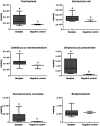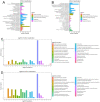Multiomics analysis reveals the presence of a microbiome in the gut of fetal lambs
- PMID: 33589511
- PMCID: PMC8040156
- DOI: 10.1136/gutjnl-2020-320951
Multiomics analysis reveals the presence of a microbiome in the gut of fetal lambs
Abstract
Objective: Microbial exposure is critical to neonatal and infant development, growth and immunity. However, whether a microbiome is present in the fetal gut prior to birth remains debated. In this study, lambs delivered by aseptic hysterectomy at full term were used as an animal model to investigate the presence of a microbiome in the prenatal gut using a multiomics approach.
Design: Lambs were euthanised immediately after aseptic caesarean section and their cecal content and umbilical cord blood samples were aseptically acquired. Cecal content samples were assessed using metagenomic and metatranscriptomic sequencing to characterise any existing microbiome. Both sample types were analysed using metabolomics in order to detect microbial metabolites.
Results: We detected a low-diversity and low-biomass microbiome in the prenatal fetal gut, which was mainly composed of bacteria belonging to the phyla Proteobacteria, Actinobacteria and Firmicutes. Escherichia coli was the most abundant species in the prenatal fetal gut. We also detected multiple microbial metabolites including short chain fatty acids, deoxynojirimycin, mitomycin and tobramycin, further indicating the presence of metabolically active microbiota. Additionally, bacteriophage phiX174 and Orf virus, as well as antibiotic resistance genes, were detected in the fetal gut, suggesting that bacteriophage, viruses and bacteria carrying antibiotic resistance genes can be transmitted from the mother to the fetus during the gestation period.
Conclusions: This study provides strong evidence that the prenatal gut harbours a microbiome and that microbial colonisation of the fetal gut commences in utero.
Keywords: intestinal microbiology.
© Author(s) (or their employer(s)) 2021. Re-use permitted under CC BY-NC. No commercial re-use. See rights and permissions. Published by BMJ.
Conflict of interest statement
Competing interests: None declared.
Figures





References
Publication types
MeSH terms
LinkOut - more resources
Full Text Sources
Other Literature Sources
